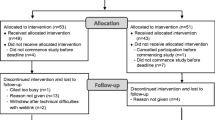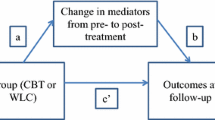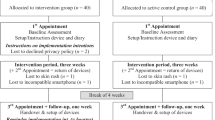Abstract
Background
Poor sleep habits and insufficient sleep represent significant workplace health issues.
Purpose
Applying self-regulation theory, we conducted a randomized, controlled trial testing the efficacy of mental imagery techniques promoting arousal reduction and implementation intentions to improve sleep behavior.
Method
We randomly assigned 104 business employees to four imagery-based interventions: arousal reduction, implementation intentions, combined arousal reduction and implementation intentions, or control imagery. Participants practiced their techniques daily for 21 days. They completed online measures of sleep quality, behaviors, and self-efficacy at baseline and Day 21; and daily measures of sleep behaviors.
Results
Participants using implementation intention imagery exhibited greater improvements in self-efficacy, sleep behaviors, sleep quality, and time to sleep relative to participants using arousal reduction and control imagery.
Conclusions
Implementation intention imagery can improve sleep behavior for daytime employees. Use of arousal reduction imagery was unsupported. Self-regulation imagery techniques show promise for improving sleep behaviors.

Similar content being viewed by others
References
Wheaton A, Liu Y, Perry G, Croft J. Effect of short sleep duration on daily activities—United States, 2005–2008. JAMA. 2011;305:1956-1957.
Kronholm E, Partonen T, Laatikainen T, et al. Trends in self-reported sleep duration and insomnia-related symptoms in Finland from 1972 to 2005: A comparative review and re-analysis of Finnish population samples. J Sleep Res. 2008;17:54-62.
Altena E, Van Der Werf YD, Strijers RLM, Van Someren EJW. Sleep loss affects vigilance: Effects of chronic insomnia and sleep therapy. J Sleep Res. 2008;17:335-343.
Niu SF, Chung MH, Chen CH, et al. The effect of shift rotation on employee cortisol profile, sleep quality, fatigue, and attention level: A systematic review. J Nurs Res. 2011;19:68-81.
Jansson-Frojmark M, Linton SJ. The role of psychological mechanisms to insomnia in its early phase: A focus on arousal, distress, and sleep-related beliefs. Psychol Health. 2008;23:691-705.
Loft MH, Cameron LD. Relationships between Sleep Priority, Work Demands, Pre-sleep Arousal and Sleep in Day-time Employees. Work Stress. In press.
Cameron LD, Chan CKY. Designing health communications: Harnessing the power of affect, imagery, and self-regulation. Soc Compass. 2008;2:262-282.
Carver CS, Scheier MF. On the Self-Regulation of Behaviour. New York: Cambridge University Press; 1998.
Hagger MS. Sleep, self-regulation, self-control and health. Stress Heal. 2010;26:181-185.
Loft MH. Response to debate on the self-report habit index. Ann Behav Med. 2012;44:141.
Tang NKY, Harvey AG. Effects of cognitive arousal and physiological arousal on sleep perception. Sleep. 2004;27:69-78.
Morin CM, Bootzin RR, Buysse DJ, et al. Psychological and behavioral treatment of insomnia: Update of the recent evidence (1998–2004). Sleep. 2006;29:1398-1414.
Schwarzer R. Self-efficacy in the Adoption and Maintenance of Health Behaviors: Theoretical Approaches and a New Model. Self-efficacy: Thought control of action. Washington, DC: Hemisphere; 1992:217-243.
Schwarzer R. Modeling health behavior change: How to predict and modify the adoption and maintenance of health behaviors. Appl Psychol Int Rev. 2008;57:1-29.
Gollwitzer PM. Implementation intentions: Strong effects of simple plans. Am Psychol. 1999;54:493-503.
Chan CKY, Cameron LD. Promoting physical activity with goal-oriented mental imagery: A randomized controlled trial. J Behav Med. 2012;35:347-363.
Martin KA, Moritz SE, Hall CR. Imagery use in sport: A literature review and applied model. Sport Psychol. 1999;13:245-268.
Hagger MS, Lonsdale A, Chatzisarantis NL. A theory-based intervention to reduce alcohol drinking in excess of guideline limits among undergraduate students. Brit J Health Psych. 2012;17:18-43.
Roffe L, Schmidt K, Ernst E. A systematic review of guided imagery as an adjuvant cancer therapy. Psycho Oncol. 2005;14:607-617.
Chan C. Approach and avoidance motivations: Development of a new assessment tool and an intervention using a self-regulatory perspective. University of Auckland: 2008.
Taylor SE, Pham LB, Rivkin ID, Armor DA. Harnessing the imagination: Mental stimulation, self-regulation, and coping. Am Psychol. 1998;53:429-439.
Buysse DJ, Reynolds CF, Monk TH, Berman SR, Kupfer DJ. The Pittsburgh Sleep Quality Index: A new instrument for psychiatric practice and research. Psychiatry Res. 1989;28:193-213.
Faul F, Erdfelder E, Lang AG, Buchner A. G*Power 3: A flexible statistical power analysis program for the social, behavioral, and biomedical sciences. Behav Res Methods. 2007;39:175-191.
Mastin DF, Bryson J, Corwyn R. Assessment of sleep hygiene using the Sleep Hygiene Index. J Behav Med. 2006;29:223-227.
Espie CA. Insomnia: Conceptual issues in the development, persistence, and treatment of sleep disorder in adults. Annu Rev Psychol. 2002;53:215-243.
Sheeran P, Webb TL, Gollwitzer PM. The interplay between goal intentions and implementation intentions. Pers Soc Psychol B. 2005;31:87-98.
Radloff LS. The CES-D Scale: A self-report depression scale for research in the general population. Appl Psych Meas. 1977;1:385-401.
Marteau TM, Bekker H. The development of a six-item short-form of the state scale of the Spielberger State-Trait Anxiety Inventory (STAI). Br J Clin Psychol. 1992;31:301-306.
Cohen S, Kamarck T, Mermelstein R. A global measure of perceived stress. J Health Soc Behav. 1983;24:385-396.
White K, Ashton R, Law H. The measurement of imagery vividness: Effects of format and order on the Betts' Questionnaire Upon Mental Imagery. Can J Beh Sci. 1978;10:68-78.
Luszczynska A, Schwarzer R. Planning and self-efficacy in the adoption and maintenance of breast self-examination: A longitudinal study on self-regulatory cognitions. Psychol Health. 2003;18:93-108.
Brickell TA, Chatzisarantis NL. Using self-determination theory to examine the motivational correlates and predictive utility of spontaneous exercise implementation intentions. Psychol Sport Exerc. 2007;8:758-770.
Nicassio PM, Mendlowitz DR, Fussell JJ, Petras L. The phenomenology of the pre-sleep state: The development of the pre-sleep arousal scale. Behav Res Ther. 1985;23:263-271.
Gueorguieva R, Krystal JH. Move over ANOVA: Progress in analysing repeated-measures data and its reflection in papers published in the archives of general psychiatry. Arch Gen Psychiat. 2004;61:310-317.
Holland RW, Aarts H, Langendam D. Breaking and creating habits on the working floor: A field experiment on the power of implementation intentions. J Exp Soc Psychol. 2006;42:776-783.
Knauper B, McCollam A, Rosen-Brown A, et al. Fruitful plans: Adding targeted mental imagery to implementation intentions increases fruit consumption. Psychol Heal. 2011;26:601-617.
Knauper B, Pillay R, Lacaille J, McCollam A, Kelso E. Replacing craving imagery with alternative pleasant imagery reduces craving intensity. Appetite. 2011;57:173-178.
Knauper B, Roseman M, Johnson PJ, Krantz LH. Using mental imagery to enhance the effectiveness of implementation intentions. Curr Psychol J Diverse Perspect Diverse Psychol Issues. 2009;28:181-186.
Morin CM, Espie CA. Insomnia: A Clinical Guide to Assessment and Treatment. New York, NY: Kluwer/Plenum; 2003.
Cunningham JA, Hodgins DC, Toneatto T, Rai A, Cordingley J. Pilot study of a personalized feedback intervention for problem gamblers. Behav Ther. 2009;40:219-224.
Chambless DL, Hollon SD. Defining empirically supported therapies. J Consult Clin Psych. 1998;66:7-18.
Taylor SE, Pham LB. The effect of mental simulation on goal-directed performance. Imagin Cogn Personal. 1998;18:253-268.
Vallieres A, Hansivers, Bastien CH, Beaulieu-Bonneau S, Morin CM. Variability and predictability in sleep patterns of chronic insomniacs. J Sleep Res. 2005;14:447-453.
Ong JC, Shapiro SL, Manber R. Combining mindfulness meditation with cognitive-behavior therapy for insomnia: A treatment-development study. Behav Ther. 2008;39:171-182.
Vincent N, Lewycky S. Logging on for better sleep: RCT of the effectiveness of online treatment for insomnia. Sleep. 2009;32:807-815.
Ohayon MM, Reynolds CF. Epidemiological and clinical relevance of insomnia diagnosis algorithms according to the DSM-IV and the International Classification of Sleep Disorders (ICSD). Sleep. 2009;10:952-960.
Conflict of Interest Statement
The authors have no conflicts of interest to disclose
Author information
Authors and Affiliations
Corresponding author
Additional information
Neither author has any conflicts of interest in that no organization has financial interest in the subject matter of this paper. This research was conducted in Auckland, New Zealand
Electronic supplementary material
Below is the link to the electronic supplementary material.
ESM 1
(DOCX 17 kb)
About this article
Cite this article
Loft, M.H., Cameron, L.D. Using Mental Imagery to Deliver Self-Regulation Techniques to Improve Sleep Behaviors. ann. behav. med. 46, 260–272 (2013). https://doi.org/10.1007/s12160-013-9503-9
Published:
Issue Date:
DOI: https://doi.org/10.1007/s12160-013-9503-9




